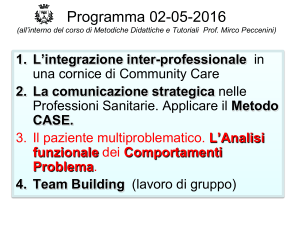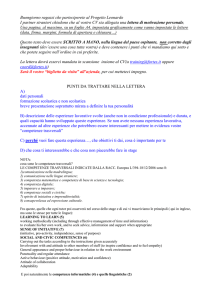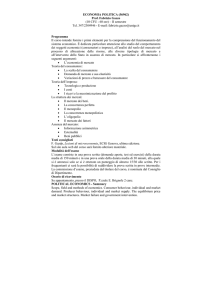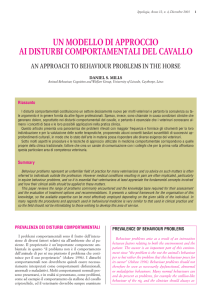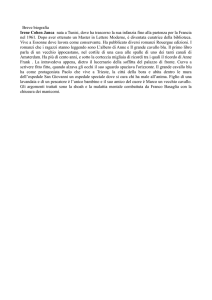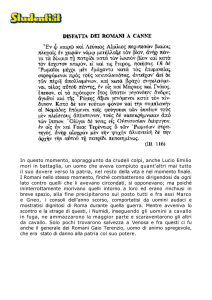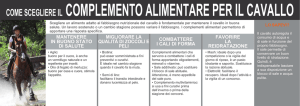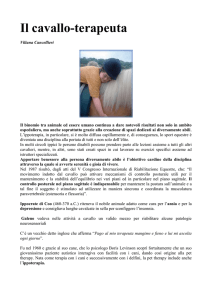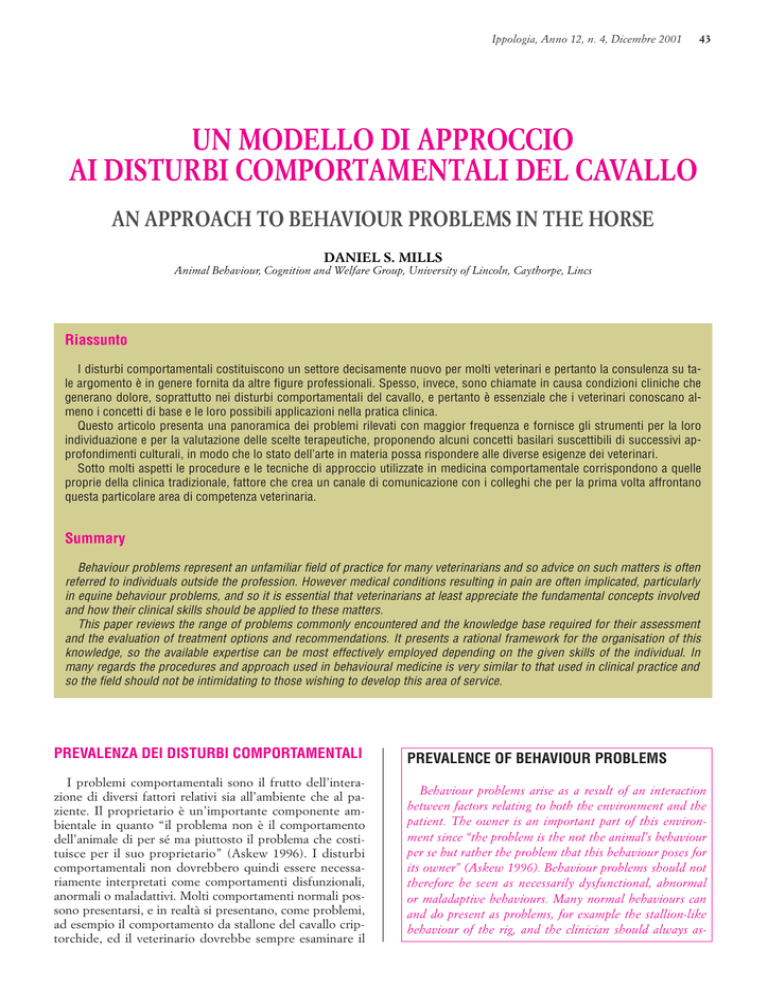
Ippologia, Anno 12, n. 4, Dicembre 2001
43
UN MODELLO DI APPROCCIO
AI DISTURBI COMPORTAMENTALI DEL CAVALLO
AN APPROACH TO BEHAVIOUR PROBLEMS IN THE HORSE
DANIEL S. MILLS
Animal Behaviour, Cognition and Welfare Group, University of Lincoln, Caythorpe, Lincs
Riassunto
I disturbi comportamentali costituiscono un settore decisamente nuovo per molti veterinari e pertanto la consulenza su tale argomento è in genere fornita da altre figure professionali. Spesso, invece, sono chiamate in causa condizioni cliniche che
generano dolore, soprattutto nei disturbi comportamentali del cavallo, e pertanto è essenziale che i veterinari conoscano almeno i concetti di base e le loro possibili applicazioni nella pratica clinica.
Questo articolo presenta una panoramica dei problemi rilevati con maggior frequenza e fornisce gli strumenti per la loro
individuazione e per la valutazione delle scelte terapeutiche, proponendo alcuni concetti basilari suscettibili di successivi approfondimenti culturali, in modo che lo stato dell’arte in materia possa rispondere alle diverse esigenze dei veterinari.
Sotto molti aspetti le procedure e le tecniche di approccio utilizzate in medicina comportamentale corrispondono a quelle
proprie della clinica tradizionale, fattore che crea un canale di comunicazione con i colleghi che per la prima volta affrontano
questa particolare area di competenza veterinaria.
Summary
Behaviour problems represent an unfamiliar field of practice for many veterinarians and so advice on such matters is often
referred to individuals outside the profession. However medical conditions resulting in pain are often implicated, particularly
in equine behaviour problems, and so it is essential that veterinarians at least appreciate the fundamental concepts involved
and how their clinical skills should be applied to these matters.
This paper reviews the range of problems commonly encountered and the knowledge base required for their assessment
and the evaluation of treatment options and recommendations. It presents a rational framework for the organisation of this
knowledge, so the available expertise can be most effectively employed depending on the given skills of the individual. In
many regards the procedures and approach used in behavioural medicine is very similar to that used in clinical practice and
so the field should not be intimidating to those wishing to develop this area of service.
PREVALENZA DEI DISTURBI COMPORTAMENTALI
PREVALENCE OF BEHAVIOUR PROBLEMS
I problemi comportamentali sono il frutto dell’interazione di diversi fattori relativi sia all’ambiente che al paziente. Il proprietario è un’importante componente ambientale in quanto “il problema non è il comportamento
dell’animale di per sé ma piuttosto il problema che costituisce per il suo proprietario” (Askew 1996). I disturbi
comportamentali non dovrebbero quindi essere necessariamente interpretati come comportamenti disfunzionali,
anormali o maladattivi. Molti comportamenti normali possono presentarsi, e in realtà si presentano, come problemi,
ad esempio il comportamento da stallone del cavallo criptorchide, ed il veterinario dovrebbe sempre esaminare il
Behaviour problems arise as a result of an interaction
between factors relating to both the environment and the
patient. The owner is an important part of this environment since “the problem is the not the animal’s behaviour
per se but rather the problem that this behaviour poses for
its owner” (Askew 1996). Behaviour problems should not
therefore be seen as necessarily dysfunctional, abnormal
or maladaptive behaviours. Many normal behaviours can
and do present as problems, for example the stallion-like
behaviour of the rig, and the clinician should always as-
44
Un modello di approccio ai disturbi comportamentali del cavallo
comportamento dell’animale in rapporto al normale comportamento specie specifico (etogramma) del paziente.
Molti altri comportamenti normali, come la risposta a stimoli dolorifici, possono diventare problemi gravi sia come
“vizi sotto sella” che nel cavallo non sellato, sebbene non
siano riconosciuti come tali al loro esordio.
È precipuo dovere del veterinario pratico definire un
ordine di priorità terapeutica, identificare e comprendere
la natura di ogni patologia, obiettivo che può essere raggiunto attraverso l’utilizzo di strumenti diagnostici di routine o supplementari.
Sono stati pubblicati diversi lavori sul rilievo e la distribuzione dei disturbi comportamentali del cavallo. Houpt
(1981) ha riportato che i problemi che le venivano più frequentemente segnalati erano i “vizi” di scuderia (come ad
esempio il ticchio d’appoggio, il ballo dell’orso, il camminare nel box etc., definiti anche stereotipie) e i comportamenti aggressivi. Più recentemente in uno studio sui problemi comportamentali non riferibili a stereotipie Somerville e colleghi (2001) rilevarono che il 29% dei proprietari incontrava difficoltà in passeggiata, il 26% riferiva problemi in scuderia del tipo reticenza da parte del cavallo a
farsi toccare la testa, il 15% riportava problemi sul terreno
di gara, il 14% durante il trasporto degli animali, il 9% riferiva problemi con il maniscalco e il 7% presentava difficoltà quando cercava di condurre l’animale. Non solo questi dati sottolineano quanto frequentemente i problemi
comportamentali insorgano nella popolazione totale, ma
denotano anche una scarsa comprensione della tendenza
naturale del cavallo ad adottare rapidamente strategie
comportamentali di evitamento come risultato dell’esperienza. La conoscenza delle caratteristiche proprie della
specie in oggetto e dei principi delle teorie dell’apprendimento sarebbero perciò d’ausilio non solo nella prevenzione di molti di questi problemi, ma sarebbero essenziali per
trattare adeguatamente i disturbi che sono ormai veri e
propri casi clinici. Si possono ottenere informazioni dettagliate su questi due argomenti specifici in Mills e Nankervis (1999) e Mills (1998). La finalità di quest’articolo è di
proporre un modello razionale per strutturare organicamente le informazioni necessarie per diagnosticare e trattare i disturbi del comportamento del cavallo.
LA NATURA DEI PROBLEMI COMPORTAMENTALI
Se la componente principale di un disturbo comportamentale da riconoscere è il problema che pone al suo proprietario, l’aspetto secondario è che quel comportamento
è costantemente modificato attraverso un circuito di tipo
“feedback”. Così il comportamento che origina il problema oggi non ha più le stesse connotazioni di quello originario; si possono infatti verificare due grandi categorie di
cambiamenti. Innanzitutto, qualsiasi comportamento motivazionale alla base determinerà delle conseguenze sulla
motivazione stessa aumentandola o riducendola nel futuro. Questo processo è definito come condizionamento
operante. Tali conseguenze potrebbero includere la risposta del proprietario che mira al controllo dell’animale ottenendo invece l’effetto opposto. Secondariamente, se il
comportamento è inizialmente elicitato da stimoli specifici, con l’esperienza potrebbero essere preannunciati da al-
sess the behaviour of the animal against the normal
species specific behaviour (ethogram) of the patient. Many
other normal behaviours, like the response to pain may
present as serious problems both under and out of the saddle, although they may not be initially recognised as such.
It is the responsibility of the veterinary surgeon to prioritise treatment, identify and define the nature of any
pathology. This can be achieved using his/her normal diagnostic and ancillary skills.
A number of surveys have been published on the range
of problems encountered. Houpt (1981) reported that the
problems most frequently referred to her were stable “vices”
(such as cribbing, weaving, box-walking etc. also referred to
as stereotypies) and aggression. More recently Somerville
and colleagues (2001) in a survey of non-stereotypic behaviour problems, found that 29% of owners encountered
problems whilst riding out, 26% had problems in the stable such as headshyness, 15% reported problems in the
field, 14% whilst travelling, 9% with the farrier and 7%
when trying to lead the animal. This not only underlies
how frequently problems arise in the general population,
but also reflects a poor understanding in the general population of the horse’s natural tendency to rapidly adopt
avoidance behaviour strategies as a result of experience. A
basic understanding of the nature of the horse and the principles of learning theory would therefore not only help prevent many of these problems but is also essential to treating
those cases that do arise. Information relating to these two
specific subjects may be found in Mills and Nankervis
(1999) and Mills (1998). The aim of this paper is to present
a rational model for the organisation of the information required to assess and treat equine behaviour problems.
THE NATURE OF BEHAVIOUR PROBLEMS
If the first feature of a behaviour problem to recognise is
the problem that it poses for its owner, the second is that behaviour is constantly being modified by feedback. So the behaviour which gives rise to the problem today does not have
the same form as the original behaviour which gave rise to
this. Two broad types of change may occur. Firstly, any motivated behaviour will have motivational consequences which
either encourage or discourage it in future. This is called operant conditioning. These consequences might include the
owners response at control which might be having the opposite to the desired effect. Secondly, if the behaviour is initially triggered by a specific stimulus, with experience these
may be predicted by or associated with other stimuli, leading to generalisation of the response. A process known as
classical conditioning. It is therefore essential to examine
the extent of these changes when trying to establish the nature of the current problem as these affect prognosis. The
prognosis is obviously worse for the owner who has allowed
the problem to change extensively from its original form as
more learning has occurred to develop the behaviour and so
more must be done to reverse this process.
Broadly speaking behaviour problems may be seen to
be derived from four conceptual categories:
1. Normal functional species typical maintenance behaviours. This includes the stallion like behaviour of a rig
Ippologia, Anno 12, n. 4, Dicembre 2001
tri stimoli, o essere associati ad essi, portando ad una generalizzazione della risposta, un processo noto come condizionamento classico. È perciò essenziale quantificare
questi cambiamenti quando si cerca di stabilire la natura
del problema presentato in quanto potrebbero influire sulla prognosi. La prognosi sarà ovviamente meno favorevole
se il proprietario ha permesso che il disturbo si modificasse ampiamente rispetto alla sua forma originale, poiché in
tal caso l’apprendimento è intervenuto pesantemente nello
sviluppo del comportamento, rendendo più arduo il recupero dell’animale.
In generale l’origine dei disturbi del comportamento
può rientrare in quattro categorie concettuali:
1. Comportamenti normali di mantenimento, tipici della
specie. Questo gruppo include il comportamento da
stallone di un cavallo criptorchide e i comportamenti di
richiesta di attenzione in una specie così gregaria come
il cavallo.
2. Risposte normali, tipiche della specie, a qualche forma
di patologia non neurologica. Potrebbe trattarsi di animali che sgroppano per un dolore alla schiena, che si
impennano perché hanno dolorabilità alla bocca o che
mal sopportano di essere maneggiati per uno stato dolorifico presente o pregresso.
3. Comportamenti associati a disfunzioni neurologiche.
Condizioni come la narcolessia e la nevralgia del trigemino che determinano lo scuotimento della testa
noto come headshaking* potrebbero rientrare in questa categoria.
4. Reazioni psicologiche a qualche forma di stress. Ciò include problemi come le stereotipie e le risposte fobiche.
*Il termine “headshaking” (lett. Scuotimento della testa)
indica un comportamento tipico del cavallo, riferibile ad
un movimento di scuotimento della testa improvviso ed
incontrollato [ndt].
Il primo punto fa riferimento ad un bagaglio culturale
che il veterinario pratico già possiede, in quanto gli permette di rilevare uno stato patologico nell’animale. La seconda e la terza categoria rappresentano aree di interesse
clinico; soltanto l’ultima costituisce probabilmente un settore innovativo.
L’ANALISI DEI DISTURBI COMPORTAMENTALI
E GLI APPROCCI TERAPEUTICI
Le cause di un comportamento possono essere lette a livelli diversi, da quello più prossimale a quello più remoto
(Mayr 1961). L’interpretazione più immediata si riferisce
ai meccanismi insiti nell’individuo che determinano l’espressione fenotipica del comportamento, descrivendo i
processi patologici ed eziologici ben noti ai veterinari nello
svolgimento della loro professione. L’interpretazione più
remota spiega il perché tali processi prossimali si devono
verificare, descrivendo la funzione o la capacità adattativa
dei processi stessi. Tinbergen (1963) ha ipotizzato che, in
tale struttura, si deve ricercare un’interpretazione esauriente del comportamento a quattro diversi livelli, distinti
l’uno dall’altro, ma complementari: filogenesi (che considera il comportamento sotto il profilo evoluzionistico),
ontogenesi (le diverse fasi di sviluppo dell’individuo nel
45
and attention seeking behaviours in a species as gregarious as the horse.
2. Normal functional species typical responses to some
form of non-neurological pathology. This might include
bucking due to back pain, rearing due to oral pain or
resentment of handling due to an active or previous
pain focus.
3. Behaviours associated with neurological dysfunction.
Conditions such as narcolepsy and trigeminal neuralgia leading to headshaking might be considered in this
category.
4. Psychological reactions to some form of stress. This includes problems such as stereotypies and phobic responses.
The first of these is obviously part of the normal
knowledge base of the practising clinician since it forms
the basis on which the diseased state can be distinguished
from the undiseased one. The second and third types of
condition represent areas of clinical knowledge; only the
last category perhaps presents a field of completely new
knowledge for the average veterinarian.
ANALYSING BEHAVIOUR PROBLEMS
AND TREATMENT APPROACHES - A FOUR
LEVEL APPROACH
The causes of behaviour may be sought at a proximate or
ultimate level (Mayr 1961). Proximate explanations relate
to mechanisms within the individual which bring about the
physical expression of the behaviour; they describe the
pathological and aetiological processes with which veterinary surgeons are familiar in normal clinical practice. The
ultimate explanations describe why such proximate processes should come about; they explain the function or adaptiveness of the processes. Tinbergen (1963) suggested that, within this framework, a full explanation of behaviour was to be
found at four distinguishable but complementary levels:
phylogeny (which describes the evolutionary history of the
behaviour), ontogeny (the life time developmental history
within an individual), mechanism and adaptive value. Emphasis is commonly given to a single dimension for a given
behaviour as one level is perceived to be central to the nature of the problem but this may also reflect the underlying
philosophy of the therapist and their approach to treatment
(Sheppard and Mills 1998). However a comprehensive approach to the management of problem behaviour should
consider both the behaviour and treatment options at all
four levels. This approach is described below in more detail.
1. Phylogeny
Phylogeny refers to the evolutionary history of the behaviour. It is therefore important to have a grasp of the
principles of evolution and how selective pressures operate. In this way a sound basis is provided for appreciating
what is natural for a horse (which may not be the same as
what is expected) and most importantly what limits to
adaptability might exist. For example, horses have
evolved to feed on forage, and so it is likely that the regulation of nutrient intake is based on “rules of thumb” de-
46
Un modello di approccio ai disturbi comportamentali del cavallo
corso della sua vita), meccanismi di base e valore adattativo. Si tende generalmente a evidenziare una dimensione
unica per ciascun comportamento in quanto si ritiene che
un unico livello sia al centro della natura del problema, ma
questo può anche riflettere la filosofia del terapeuta ed il
suo approccio terapeutico (Sheppard e Mills 1998). In
ogni caso un’analisi bilanciata del disturbo comportamentale dovrebbe considerare il comportamento e le alternative terapeutiche a tutti e quattro i livelli. La parte seguente
propone nel dettaglio proprio questa tecnica di approccio.
1. Filogenesi
La filogenesi considera il comportamento sotto il profilo
evoluzionistico. È quindi importante accennare ai principi
dell’evoluzione e alle modalità di pressione selettiva. In
questo modo si fornisce una base per comprendere tutto
ciò che è assolutamente “naturale” per un cavallo (anche se
può non corrispondere alle nostre aspettative) e, elemento
fondamentale, quali sono i possibili limiti della sua capacità
adattativa. Ad esempio, i cavalli si sono evoluti come erbivori, ed è così probabile che la regolazione dell’assunzione
del nutrimento sia fondata su “regole pratiche” derivanti
dal consumo di una dieta a base di foraggio. Il processo
non si è modificato nel tempo in quanto non si sarebbe ottenuto alcun vantaggio selettivo in senso biologico, anche
se oggi molti cavalli domestici seguono una dieta essenzialmente a base di mangimi, un sistema di alimentazione che
potrebbe richiedere all’organismo animale nuove norme
per un’efficace regolazione dell’assunzione del nutrimento.
Così vi è un potenziale conflitto tra le attuali pratiche gestionali e la tendenza evolutiva (“divario genetico” sensu
McGuire e Troisi 1998). Quando si identificano gli estremi
di questa potenziale conflittualità nell’ambito di un disturbo comportamentale, è probabile che l’animale sia al limite
della sua capacità adattativa (Fig. 1).
Il trattamento che è mirato a risolvere la causa di problemi di questo tipo dovrà perciò essere incentrato su
cambiamenti nella gestione dell’animale, poiché la potenzialità per modificare il paziente stesso è probabilmente
molto bassa. In questi casi, se l’intervento terapeutico ha
soltanto la finalità di impedire l’emissione del comportamento, è probabile che risulti essere un ulteriore fattore
stressante legato a frustrazione o ad aumentata difficoltà
d’adattamento (McGreevy e Nicol 1998). Il trattamento
dovrebbe essere diretto a quelle cause prossimali che sono
rilevanti per il benessere del paziente. Questo non implica
necessariamente la scelta di un ambiente totalmente naturale piuttosto che uno al quale l’animale possa effettivamente adattarsi. Se vi è una reale necessità comportamentale, nel senso che l’animale “ha bisogno” di emettere dei
comportamenti legati all’assunzione di foraggio, si può
sfruttare l’impiego di un dispositivo che agisca consentendo un aumento dell’emissione dei comportamenti alimentari, come ad esempio l’EquiballTM, senza aumentare di per
sé la quantità di foraggio (Henderson et al., 1997). Comunque, se il problema è associato ad uno stato di frustrazione prossimale un dispositivo di questo genere potrebbe
esacerbare il disturbo poiché il cavallo potrebbe non essere predisposto ad utilizzare tali modalità nell’assunzione
del cibo dal punto di vista filogenetico.
rived from the consumption of a forage based diet. There
has been no selective advantage in a biological sense for
modification of this process even though many domestic
horses may now be fed a largely concentrate diet whose
efficient regulation might require different rules. There is
thus a potential conflict between current management
practice and evolved tendency (“genome lag” sensu
McGuire and Troisi 1998). When such areas of potential
conflict are identified within a problem, it is likely that
the subject is at the limit of its adaptive capacity (Fig. 1).
Treatment which focuses on the cause of any such problems will therefore need to focus on a change in management as the potential for change in the patient is probably
at its limit. If treatment in these cases aims only at prevention then further stress due to frustration or increased
difficulty in coping is likely to result (McGreevy and Nicol
1998). Treatment should address the proximate causes
which are relevant to the well-being of the patient. This
does not necessitate a totally natural environment rather
an environment to which the animal can effectively adapt.
If there is a genuine behavioural need to forage it may be
that the provision of a toy which encourages such behaviour, such as the “EquiballTM” satisfies such a requirement
without the need for increased forage per se (Henderson
et al., 1997). However if the problem is associated with a
proximate frustration of feeding such a device could exacerbate the problem as the horse may not be phylogenetically adapted to work in such a way for food.
2. Ontogeny
Ontogeny describes the development of the behaviour
within an individual; it is the clinical and ethological history of the case and how learning has modified it. These
are obviously all essential components to the evaluation of
any behaviour. Three phenomena of particular importance
within the ontogenetic process are emphasised here,
namely: sensitive phases in development, behavioural
maturation and learning.
Sensitive phases, like the prenatal, neonatal, transitional and socialisation periods, have traditionally formed the
focus of ethological descriptions of development but are
commonly misunderstood. During these phases the young
horse may be particularly open to making certain associations. Qualitative and quantitative aspects of sensory input at this time have a lasting effect and may lead to later
problems although their effects can usually be reversed albeit with difficulty (Bateson 1979).
Imprinting and attachment onto the maternal figure is
traditionally reported to occur during the neonatal period
which covers the first few hours of the foal’s life (Rossdale
1967). Imprinting onto an inappropriate object, such as a
human can result in both filial and, later on, sexual behaviour being directed towards the imprint object (Bateson
1991). Occasionally, strong attachments to bizarre objects
present at the time of birth may form; for example Tyler
(1972) reports that the attachment of a new-born foal to a
certain tree may occasionally disrupt the mare-foal bond.
Similar problems may arise in the domestic situation, with
attachment to hay mangers and other stable fittings occa-
Ippologia, Anno 12, n. 4, Dicembre 2001
A
Risposte adattative
presenti nel cavallo
ma non necessarie
in cattività
Risposte adattative
che possono essere
utilizzate in cattività
per permettere al cavallo
di adeguarsi
positivamente
all’ambiente
Risposte adattative presenti nei cavalli come
risultato della selezione naturale e di quella
operata dall’uomo, rispettivamente negli ambienti
selvatico e domestico
Nessuna risposta adattativa
presente nel cavallo:
difficoltà o incapacità
dell’animale di adeguarsi
positivamente all’ambiente
B
Risposte adattative necessarie
al cavallo in cattività
FIGURA 1 - Diagramma di Venn che illustra i problemi relativi al “divario genetico” nella popolazione del cavallo domestico (adattato da Fraser et al.,
1997). All’aumentare della sovrapposizione di A su B, si riduce il divario e, di conseguenza, si riduce il rischio di insorgenza di problemi relativi allo stato
di benessere degli animali attribuibili ad un adattamento inadeguato.
A
Adaptations
possessed
but not required
in the captivity
Adaptations which
can be used
in captivity to allow
horse to cope
adequately
Adaptations possessed by horses as a result of
natural selection in the wild and manmade
selection in the domestic environment
No suitable
adaptation possessed
by horse, so difficulty
or inability to cope
B
Adaptations required by the
horse in captivity
FIGURA 1 - Venn diagram illustration of the problems due to the “genome lag” in the domestic horse population (adapted after Fraser et al., 1997). The
greater the overlap between A and B, the small the lag and the lower the risk of welfare problems arising due to inadequate adaptation.
47
48
Un modello di approccio ai disturbi comportamentali del cavallo
2. Ontogenesi
L’ontogenesi descrive le fasi di sviluppo del comportamento nell’individuo; è l’anamnesi clinica ed etologica del
caso e l’esame delle modificazioni operate dall’apprendimento. Si tratta ovviamente di punti essenziali per la valutazione
di qualsiasi comportamento. In questa sede si evidenziano
tre fenomeni di particolare importanza nell’ambito del processo ontogenetico e precisamente le fasi sensibili nello sviluppo, la maturazione comportamentale e l’apprendimento.
Le fasi sensibili, e cioè i periodi prenatale, neonatale, di
transizione e di socializzazione, costituiscono tradizionalmente il fulcro delle descrizioni etologiche dello sviluppo,
ma alcuni concetti sono in genere fraintesi. In queste fasi il
cavallo giovane è particolarmente disponibile nell’operare
certe associazioni. Gli input sensoriali, diversi per quantità
e qualità, che arrivano all’animale in tale momento hanno
un effetto duraturo e possono portare successivamente alla
comparsa di problemi, sebbene gli effetti siano di solito reversibili, anche se con difficoltà (Bateson 1979).
Si riporta generalmente che l’imprinting e l’attaccamento
alla figura materna si attuano durante il periodo neonatale,
identificato con le prime ore di vita del puledro (Rossdale
1967). L’imprinting verso un oggetto inappropriato, come ad
esempio un essere umano, può esitare in comportamenti filiali e, successivamente, in comportamenti sessuali, diretti verso
l’oggetto d’imprinting (Bateson 1991). Occasionalmente si
sviluppa un forte attaccamento verso determinati oggetti presenti al momento della nascita; ad esempio Tyler (1972) riferisce che l’attaccamento di un puledro neonato ad un certo
albero può talvolta spezzare il legame madre-figlio. Problemi
di questo genere possono sorgere nelle condizioni domestiche, in cui si può sporadicamente formare un attaccamento
del puledro a mangiatoie ed altri arredi della scuderia. L’importanza delle esperienze precoci è chiaramente dimostrata
dai lavori scientifici sui problemi che nascono dall’esposizione a stimoli inadeguati durante le prime fasi dello sviluppo
dell’animale. Grzimek (1949) ha dimostrato che i puledri gestiti in isolamento sociale dagli altri cavalli diventavano timorosi nei confronti dei conspecifici quando erano poi introdotti nel gruppo. Williams (1974) ha riportato che puledri nutriti
artificialmente mediante un sistema meccanico di allattamento preferivano la compagnia dell’uomo a quella dei cavalli e
non rispondevano con modalità appropriate ai segnali sociali
dei conspecifici. Non tutti i disturbi comportamentali del puledro, o più specificatamente del puledro privato della madre, sono problemi di imprinting o semplicemente implicano
manifestazioni aberranti di una programmazione genetica,
ma piuttosto riflettono la complessa interazione tra ambiente
e genotipo (epigenesi, Waddington 1961) durante questo
passo cruciale dello sviluppo comportamentale.
La maturazione comportamentale può anche influenzare lo sviluppo dei comportamenti problematici in particolari momenti, vale a dire che lo sviluppo fisico del cavallo
è associato alla comparsa di determinati moduli comportamentali. Ad esempio l’espressione del comportamento sessuale dipende dalla maturazione fisica delle gonadi; quando ciò si attua un puledro facilmente trattabile può diventare più difficile da gestire. Se un problema comportamentale è associato (piuttosto che semplicemente correlato) ad
una particolare fase di sviluppo, è probabile che sia soggetto ad un maggior controllo endogeno. Se un intervento
sionally occurring. The importance of early experience is
clearly demonstrated by the scientific reports of problems
arising from inappropriate exposure during early development. Grzimek (1949) showed that foals reared in social
isolation of other horses became fearful of conspecifics
when they were finally introduced. Williams (1974) reported that foals reared on a mechanical nursing system
preferred human company to that of horses and failed to
respond appropriately to the social signals of conspecifics.
Not all behaviour problems arising in the foal or more especially the orphan foal are problems of imprinting or simply aberrant manifestations of a genetic programme, but
rather reflect the complex interaction of the environment
with the genotype (epigenesis, Waddington 1961) during
this important stage of behaviour development.
Behavioural maturation may also influence the development of problem behaviours at particular times, i.e. the
physical development of the horse is associated with the
emergence of particular behaviour patterns. For example
the expression of sexual behaviour, depends on the physical maturation of the gonads, at this point a previously
tractable colt may become more difficult to handle. If a
behaviour problem is associated (rather than simply correlated) with a particular stage of development, it is likely
to be subject to a greater degree of endogenous control. If
internal intervention e.g. castration or pharmacotherapy is
not possible then the prognosis is inevitably poorer than a
purely learned problem.
Learning may represent the dominant feature of the
problem, as occurs in learned habits but it is also central
to the difference between the current problem behaviour
and its initial expression. This relationship must accordingly be examined in all cases.
Learning in the horse and the problems which can arise
as a result of conditioning or the misapplication of learning theory have been reviewed elsewhere - see Cooper
(1998) for a review of learning in the horse and Mills
(1998) for a review of learned problems. They will not
therefore be reviewed here, but it is worth re-emphasising
how an animal’s experiences with the environment affects
the development and form of a behaviour. Thus the colt,
which was physically punished as it became difficult to
handle when it physically matured, may now show an
avoidance or fear of the handler resulting in secondary
problems like defensive kicking or biting. Even if the association with maturation is recognised, these problems
will persist even following castration as their development
is dependent upon conditioning rather than hormonal factors. In some cases, the initial association is not recognised and the secondary problems are the primary cause of
complaint. Only a full behavioural history will identify
the role of such factors and allow an accurate prognosis
for treatment to be made. A behavioural history must
therefore examine both previous management and experience as well as current status with regards to development
and management, including details of any effects at correction of the problem already taken and their effect.
Treatments which focus on addressing the developmental
aspects of the problem include psychotherapy and retraining.
This involves the controlled manipulation of the environment
to shape future development and recondition the animal.
Ippologia, Anno 12, n. 4, Dicembre 2001
a livello fisiologico come ad esempio la castrazione o un
trattamento farmacologico sono inattuabili, allora la prognosi è inevitabilmente più sfavorevole che nel caso di un
problema che è soltanto frutto dell’apprendimento.
L’apprendimento può costituire la componente principale del problema, come si verifica nei comportamenti appresi mediante abituazione, ma è anche rilevante per la
differenza tra il comportamento problematico osservato e
la sua espressione iniziale. Questa relazione deve perciò
essere analizzata in qualsiasi caso comportamentale.
L’apprendimento nel cavallo e i problemi che possono sorgere come risultato del condizionamento o dell’errata applicazione delle teorie sull’apprendimento sono state esaminate
in altra sede - vedi Cooper (1998) per una rassegna sull’argomento nel cavallo e Mills (1998) per una disamina delle problematiche sull’apprendimento. Perciò tali tematiche non saranno affrontate in quest’ambito, ma è opportuno sottolineare nuovamente come le esperienze ambientali vissute dall’animale influiscano sullo sviluppo e sull’espressione del comportamento. Così il puledro, che veniva punito fisicamente
poiché diventato difficile da gestire dopo la sua maturazione
fisica, può mostrare ora reazioni di evitamento o di paura nei
confronti della persona che se ne occupa, risposte che possono esitare in problemi secondari come calci o morsi di tipo
difensivo. Anche se si ammette la loro associazione con la fase di maturazione, questi disturbi persisteranno anche in seguito alla castrazione poiché il loro sviluppo dipende dal
condizionamento piuttosto che da fattori ormonali. In alcuni
casi l’associazione iniziale non viene riconosciuta e i disturbi
secondari sono in realtà quelli proposti come problema principale. Soltanto un’anamnesi comportamentale approfondita
individuerà il ruolo di questi fattori e permetterà una prognosi accurata e l’impostazione di un piano terapeutico adeguato. Un’anamnesi comportamentale deve perciò considerare sia la gestione dell’animale e le sue esperienze precedenti
sia la situazione del momento in riferimento allo sviluppo e
alle pratiche gestionali, includendo informazioni dettagliate
sui metodi di correzione utilizzati e gli effetti rilevati.
I trattamenti che agiscono sullo sviluppo includono tecniche di psicoterapia e di riabilitazione. Quest’ultima indica un
intervento di controllo sull’ambiente per modellare lo sviluppo futuro dell’animale e ricondizionarlo. Comunque, è importante tenere conto dei limiti di questa tecnica come descritto nel metodo di approccio proposto, che opera a quattro diversi livelli. Un intervento fisiologico, di tipo farmacologico o chirurgico, potrebbe rendersi necessario per facilitare la riabilitazione in riferimento all’attuale stato fisiologico
(vedi oltre). Comunque tali rimedi devono essere considerati
come una misura di sostegno e non un trattamento della
causa del problema quando adottati in questo contesto.
3. Meccanismi di base
Interpretazioni meccanicistiche del comportamento tendono a focalizzarsi sulle basi fisiologiche ed anatomiche
della sua causa immediata. Perciò a questo livello le fasi
sensibili descritte precedentemente rappresentano un periodo di adattamento “neuroplastico” in risposta a determinati input sensoriali, stimoli quantitativamente e qualitativamente diversi, durante le prime fasi di sviluppo (Wolff
1981). Il veterinario, utilizzando la chirurgia e le diverse
49
However, it is equally important to recognise the limits of this
technique as illustrated by this four level approach. Physiological intervention through the use of drugs and surgery may be
necessary to facilitate retraining due to the animal’s current
physiological state (see below). However, such aids must be
recognised as a support measure and not a treatment of the
cause of the problem when used in this context.
3. Mechanism
Mechanistic explanations of behaviour tend to focus on
the physiological and anatomical basis of its immediate
causation. Thus at this level the sensitive phases described
above represent a period of neuroplastic adaptation in response to quantitative and qualitative aspects of sensory
input during early development (Wolff 1981). The veterinary surgeon, through the application of surgery and therapeutics, is in a unique position to understand and treat
the mechanistic aspects of a behaviour problem, but this
does not necessarily mean the cause is being addressed.
When medical and biochemical explanations are offered for a behaviour, they relate to this level of description. This might include the role of allergic rhinitis and
other pathologies in equine headshaking (Cook 1980) or
the importance of serotonin, dopamine and the opiates in
the expression of stereotypic behaviour (Cooper and Dourish 1990). It can be difficult to distinguish between cause
and effect when biochemical models are proposed for psychological conditions. Thus lowered serotonin levels in
the depressed subject may be a reflection of the current
state rather than a cause of it. In the former case treatment with serotonin reuptake inhibitors, like
clomipramine, may relieve the problem by preventing the
formation of the psychological condition but may not actually be addressing the biological cause of the problem.
The use of drugs and surgery to treat behaviour problems focuses on intervention at this level and is a cause
for some controversy. Castration of a rig, undoubtedly addresses the cause of stallion-like behaviour, but myectomy
or combined neurectomy and myectomy (Hakansson et
al., 1992) to control crib-biting supposedly results in an
animal that is no longer physically capable of the behaviour. Whilst this may achieve the aesthetic goal it is likely
to exacerbate the stress of the patient since the cause has
not been addressed (McGreevy and Nicol 1998). However, the use of antidepressants like clomipramine to treat
self-mutilation in stallions (Shuster and Dodman 1998)
may relieve certain aspects of the psychological suffering
associated with the behaviour. Again this emphasises the
importance of a four level approach to the comprehensive
understanding of the problem.
4. Adaptiveness
The adaptiveness of a behaviour relates to its function
and the rules regulating its expression. This is a central
theme of the science of behavioural ecology (Krebs and
Davies 1993). Four categories of behavioural adaptation
may be considered in a clinical context.
50
Un modello di approccio ai disturbi comportamentali del cavallo
forme terapeutiche, è nella posizione ottimale per comprendere e trattare gli aspetti meccanicistici del problema
comportamentale, ma questo non implica necessariamente
che si agisca sulla causa del disturbo.
Le interpretazioni mediche e biochimiche riferite ad un
particolare comportamento si riferiscono a questo livello descrittivo; un esempio nel cavallo può essere il ruolo della rinite allergica e di altre patologie nell’headshaking (Cook
1980) o dell’importanza della serotonina, della dopamina e
degli oppiacei nell’espressione delle stereotipie (Cooper and
Dourish 1990). Può essere arduo distinguere tra causa ed effetto quando si propongono modelli biochimici per condizioni psicologiche. Così la riduzione dei livelli di serotonina
nel soggetto depresso può essere il riflesso dello stato emozionale piuttosto che una sua causa. Nel primo caso il trattamento con gli inibitori selettivi della ricaptazione di serotonina, come la clomipramina, possono alleviare il disturbo impedendo il consolidamento della condizione psicotica, ma
non può in realtà colpire la causa biologica del problema.
L’impiego di farmaci e di tecniche chirurgiche per il trattamento dei disturbi comportamentali sono il fulcro dell’intervento a questo livello, e sono motivo di qualche controversia.
La castrazione di un soggetto criptorchide indubbiamente
colpisce la causa di un comportamento da stallone, ma la
miectomia, o una combinazione di neurectomia e miectomia
(Hakansson et al., 1992) per controllare il ticchio d’appoggio
produce un animale che non è più fisicamente in grado di
emettere il comportamento. Se da un lato un provvedimento
del genere può rispondere ad esigenze estetiche è probabile
che esacerbi lo stress del paziente in quanto non si mira alla
causa (McGreevy and Nicol 1998). Comunque, la somministrazione di antidepressivi come la clomipramina per trattare
fenomeni di auto-mutilazione negli stalloni (Shuster e Dodman 1998) può alleviare certi aspetti della sofferenza psicologica associata al comportamento. Nuovamente questo enfatizza l’importanza di un approccio su quattro livelli per
una chiara comprensione del problema.
4. Valore adattativo
La capacità di adattamento di un comportamento è in
relazione alla sua funzione e ai principi che ne regolano
l’espressione. Questo è un tema di fondo della branca
scientifica dell’ecologia comportamentale (Krebs e Davies
1993). In un contesto clinico si devono considerare quattro diverse categorie di adattamento comportamentale.
Innanzitutto, alcuni comportamenti sono veramente
adattativi perché raggiungono il loro obiettivo, come ad
esempio le minacce aggressive determinano la cessazione
di un’esperienza aversiva. Molti problemi comportamentali hanno un significato adattativo che non è riconosciuto
dal proprietario; ad esempio il cavallo che morde senza
un’evidente giustificazione può aver imparato che le minacce di livello inferiore sono completamente ignorate.
Secondariamente, un comportamento può essere soltanto
parzialmente adeguato come tentativo di adattamento ad una
certa situazione. Il mancato raggiungimento dell’obiettivo
dell’adattamento esiterà in un cambiamento della strategia o
in un’intensificazione del comportamento, nel tentativo di
adattarsi al meglio alle diverse circostanze. Questo genere di
comportamento può palesarsi laddove vi è un divario geneti-
Firstly, some behaviour is truly adaptive because it
achieves its goal, for example aggressive threats result in
the cessation of an aversive experience. Many behaviour
problems have adaptive significance which is not recognised by the owner. For example the horse that bites for
no apparent reason, may have learned that lower level
threats are ignored.
Secondly, a behaviour may be only partially adequate as
an attempt to adapt to a given situation. Failure to
achieve the adaptive goal will result in a change of strategy or intensification of the behaviour in an effort to cope
as best as possible given the circumstances. This sort of
behaviour may be evident in circumstances where there is
a genome lag as described in the phylogeny section above.
For example, Nicol (1999) has suggested that cribbing
may be an attempt by the horse to produce saliva to buffer
against the increased acidity in the stomach caused by the
ration feeding of concentrates. Horses normally produce
saliva only when they are chewing. Therefore when feeding the daily allowance in meals, the total time spent
chewing and thus producing alkaline saliva is reduced
with the result that gastric acidity increases and ulceration
commonly results. Cribbing is not as effective as chewing
on forage for the production of saliva (Houpt, personal
communication), and so the behaviour intensifies. It is an
unsuccessful attempt at adaptation as evidenced by the occurrence of ulcers (Nicol et al., 2001).
Thirdly a behaviour may represent an adaptive but
non-functional response. In this case the animal’s behaviour may be adaptive in a different context but it is ineffective in the current environment. This occurs because
behaviour is controlled by the mechanisms which have
been favoured through natural selection, even though
they may be inappropriate in the current environment.
For example, separation related behaviours which can
cause a problem in the domestic setting have adaptive value in particular settings, such as within a free roaming social group (McGuire and Troisi 1998, Stevens and Price
1997). In this context they help increase the chance of separated individuals being re-united, however in the domestic setting the barriers and control imposed by man make
this response redundant.
Fourthly the behaviour may be truly maladaptive, in
which case a physical pathology and chronic motivational
conflict should be considered and investigated. For example violent headshaking often serves no function but is a
general response to head pain.
In circumstances of motivational conflict or frustration,
the horse may express displacement, ambivalent, redirected or aggressive behaviour. Displacement behaviour is “an
unexpected, seemingly irrelevant movement that occurs
out of the behavioural context to which it is assumed to
belong functionally” (Immelmann and Beer 1989). In
horses, it would seem that the most common form of displacement behaviour relates to grazing. Thus the horse
faced with a conflict between avoiding an apparently aversive situation and approaching it under the instruction of
its rider, may suddenly pull at some nearby grass. This is
often misinterpreted by the rider as a form of stubbornness
and results in punishment of the horse. This is only likely
to exacerbate the problem. Aggressive behaviour in a simi-
Ippologia, Anno 12, n. 4, Dicembre 2001
co come riportato nella sezione sulla filogenesi. Ad esempio
Nicol (1999) ha ipotizzato che il ticchio d’appoggio possa essere un tentativo da parte del cavallo di produrre saliva per
tamponare l’aumentata acidità nello stomaco causata da un’alimentazione a base di mangimi. I cavalli normalmente producono saliva soltanto quando masticano. Perciò quando si
suddivide la razione giornaliera in diversi pasti, il tempo complessivo dedicato alla masticazione, e con esso la produzione
di saliva alcalina, è ridotto con il risultato che l’acidità gastrica
aumenta, causando in genere la formazione di ulcere. Il ticchio d’appoggio non è così efficace come la masticazione del
foraggio per la produzione di saliva (Houpt, comunicazione
personale), e così il comportamento si intensifica. Si tratta di
un tentativo di adattamento infruttuoso come si evince dal
frequente rilievo di ulcere gastriche (Nicol et al., 2001).
Terzo, un comportamento può rappresentare una risposta adattativa ma non funzionale. In questo caso il comportamento dell’animale può essere adattativo in un altro contesto, ma è inefficace nell’ambiente attuale. Ciò si verifica
perché il comportamento è controllato da meccanismi che
sono stati favoriti negli animali mediante la selezione naturale, anche se possono essere inappropriati nell’ambiente in
cui essi vivono. Ad esempio, i comportamenti legati a separazione che possono diventare un problema nel contesto
domestico hanno un valore adattativo in altre situazioni, come in un gruppo sociale che vive in condizioni di libertà
(McGuire e Troisi 1998, Stevens e Price 1997). In tale contesto servono ad accrescere la possibilità che gli individui
che si sono allontanati si riuniscano al gruppo; comunque in
condizioni di vita domestica le barriere e le modalità di controllo imposte dall’uomo amplificano questa risposta.
Quarto, il comportamento può essere realmente maladattativo, nel qual caso una patologia fisica e un conflitto
motivazionale cronico dovrebbero essere analizzati ed investigati. Per esempio un violento scuotimento della testa
spesso non assolve alcuna funzione, ma è una risposta generica ad una dolorabilità alla testa.
In condizioni di conflitto motivazionale o di frustrazione, il cavallo può manifestare un comportamento di dislocazione, ambivalente, ridiretto o aggressivo. Il comportamento di dislocazione è un “movimento inatteso, verosimilmente irrilevante, che si verifica al di fuori del contesto
comportamentale al quale si presume appartenga sotto il
profilo funzionale” (Immelmann e Beer 1989). Nei cavalli
sembrerebbe che la forma più comune di comportamento
di dislocazione sia riferito all’andare al pascolo. Così il cavallo che è messo di fronte alla scelta tra l’evitare una situazione apparentemente aversiva o l’avvicinarsi seguendo le
istruzioni del suo cavaliere può improvvisamente dirigersi
verso l’erba più vicina. Questo fenomeno è spesso frainteso
dal cavaliere che lo interpreta come una forma di ostinazione e reagisce punendo il cavallo, atteggiamento che probabilmente esacerba soltanto il problema. Il comportamento
aggressivo in un contesto simile è spesso parimenti frainteso e determina le stesse conseguenze. Il comportamento ridiretto, che è un normale comportamento diretto ad un
obiettivo diverso dall’originario in quanto viene impedito il
raggiungimento dell’obiettivo primario, e i comportamenti
ambivalenti (comportamenti che includono parti di due
comportamenti antagonisti) possono sottogiacere allo sviluppo di certe stereotipie (McFarland 1966). Ad esempio il
ballo dell’orso può rappresentare una forma di comporta-
51
lar context is often equally misunderstood with the same
consequences. Redirected behaviour (i.e. normal behaviour
directed at an alternative substrate due to frustration towards the primary focus) and ambivalent behaviours (behaviours incorporating parts of two antagonistic behaviours) may underlie the development of certain stereotypical behaviours (McFarland 1966). For example weaving
may represent a form of ambivalent behaviour relating to
locomotory frustration (Mills and Nankervis 1999).
Evaluation of a behaviour at all four levels, not only facilitates an assessment of differential diagnoses, but also
helps reveal the most appropriate course of action. For example, consider a weaving horse. At the phylogenetic level we believe the problem may arise from the inappropriateness of housing a social animal in isolation and addressing this will be central to resolving the cause of the
problem in a given case. Assessing the development of the
problem in an individual will give valuable information
about the extent to which the problem may have generalised and its specific triggers. Some of these may be managed so that they can be avoided as a possible treatment
option. Our current understanding of the mechanistic basis of the behaviour relates to the role of dopamine, serotonin and endogenous opiates in the regulation of behaviour and suggests that most available pharmacological
preparations are only likely to be effective by causing a
general depression of behaviour or compromising welfare
further. Current evidence suggests that the behaviour has
adaptive value through causing a degree of derousal that
helps the animal to cope with the current environment, so
prevention of the behaviour is inappropriate for good welfare. Accepting that social housing is not a viable option,
Mills and Davenport (in press) have evaluated the use of a
mirror in the stable as a substitute with favourable results. Given the four level approach it becomes apparent
that this is a sound practical solution for the problem
which is unlikely to compromise the horse’s well-being
unlike weaving grills or hobbles.
CONCLUSION
The greater an individual’s knowledge in each of these
four fields, the greater their potential to understand the
nature of a behaviour problem and to devise sensitive solutions which respect the welfare of the horse. Whilst
some of the factual information required may be new to
the veterinary surgeon, the paradigm in which it is used is
a familiar to those working in clinical practice; i.e. for any
given case there is a need for a thorough history, assessment of the patient (including clinical examination) and
evaluation of differential diagnoses before recommendations for treatment made. The veterinary surgeon is thus
well placed to deal with behaviour problems as he has
both the essential clinical skills and also much of the essential knowledge base.
Key words
Horse, behaviour, problem, assessment.
52
Un modello di approccio ai disturbi comportamentali del cavallo
mento ambivalente in riferimento a frustrazione espressa a
livello locomotorio (Mills e Nankervis 1999).
L’analisi di un comportamento a tutti e quattro i livelli
non soltanto facilita la valutazione delle diagnosi differenziali, ma fornisce anche indicazioni su come procedere. Si consideri ad esempio un cavallo con il ballo dell’orso. A livello
filogenetico si ritiene che il problema nasca dal fatto di detenere un animale sociale in situazioni di isolamento e un intervento mirato su questo punto sarà il fulcro per risolvere la
causa del disturbo. Valutare lo sviluppo del problema in un
individuo fornirà informazioni preziose sullo stadio di generalizzazione del problema e sugli specifici stimoli elicitanti,
ed alcuni di essi potranno essere utilizzati come possibile
opzione terapeutica nel senso di essere evitati. Le nostre attuali conoscenze sui meccanismi di base del comportamento
si riferiscono al ruolo della dopamina, della serotonina e degli oppiacei endogeni nella regolazione del comportamento,
suggerendo che la maggior parte dei farmaci disponibili sono efficaci determinando una drastica riduzione del comportamento in generale o compromettendo ulteriormente
un già precario stato di benessere. La constatazione pratica
suggerisce che il comportamento ha un valore adattativo
mediante l’abbassamento della soglia di reattività che aiuta
l’animale ad adeguarsi positivamente all’ambiente attuale, di
modo che l’impedire il comportamento è inappropriato se si
desidera garantire uno stato di benessere all’animale. Considerando che la sistemazione del cavallo in “collettività” non
è un’opzione realistica, Mills e Davenport (in stampa) hanno
valutato in sostituzione dell’intervento sociale l’uso di uno
specchio in scuderia ottenendo risultati incoraggianti. Tenendo conto dell’approccio proposto, che si fonda su quattro diversi livelli, è evidente che si tratta di una soluzione
pratica che ha scarse probabilità di compromettere lo stato
di benessere del cavallo a differenza dei vari sistemi che mirano soltanto ad impedire l’emissione del comportamento
come le griglie antidondolamento o le pastoie.
CONCLUSIONI
Approfondendo la conoscenza delle nozioni di base proprie di ciascuna delle quattro branche sopra citate, si potrà
ottenere una miglior comprensione della natura del problema comportamentale e sarà possibile trovare soluzioni realistiche nel rispetto del benessere del cavallo. Sebbene alcune
delle informazioni necessarie possano essere un campo nuovo per il veterinario pratico, il paradigma utilizzato è ben
noto nella clinica tradizionale; per esempio in ciascun caso
clinico è assolutamente indispensabile raccogliere un’anamnesi accurata, esaminare il paziente (includendo l’esame fisico del soggetto) e valutare un diagnostico differenziale prima di procedere con l’impostazione del piano terapeutico.
Si ritiene quindi che il veterinario sia la figura professionale
più adatta per affrontare i disturbi comportamentali, in
quanto depositario non solo delle indispensabili nozioni cliniche ma anche delle necessarie conoscenze teoriche.
Parole chiave
Cavallo, comportamento, disturbo comportamentale,
valutazione.
Bibliografia/References
Askew HR (1996) Treatment of Behavior Problems in Dogs and Cats.
Blackwell Science, Oxford.
Bateson P (1979) How do sensitive periods arise and what are they for?
Anim. Behav. 27, 470-486.
Bateson P (1991) Are there principles of behavioural development? In: Bateson P, Ed.: The development and integration of behaviour. Cambridge
University Press, Cambridge. 19-40.
Cook WR (1980) Headshaking in horses. Part 4: special diagnostic procedures. Vet Med. Eq. Pract. 2, 7-15.
Cooper JJ (1998) Comparative learning theory and its application to the training of horses. Equine vet J. Suppl. 27: 39-43.
Cooper SJ, Dourish CT (1990) Neurobiology of Stereotyped Behaviour, Clarendon Press, Oxford.
Fraser D, Weary DM, Pajor EA, Milligan BN (1997) A scientific conception of
animal welfare that reflects ethical concerns. Anim. Welfare 6, 187-205.
Grzimek B (1949) Ein Fohlen, des kein Pferd kannte. Z. Tierpsychol. 6,
391-405.
Hakansson A, Franzen P, Petersson H, (1992) Comparison of two surgical
techniques for treatment of crib-biting in horses. Equine vet J. 24,
494-496.
Henderson JV, Waran NK, Young RJ, (1997) Behavioural enrichment for
horses: The effect of foraging device (the “Equiball”) on the performance of stereotypic behaviour in stabled horses. In: Mills DS, Heath
SE, Harrington LJ, Eds.: Proc. First Int. Conf. Vet. Behavioural Med.,
UFAW, Potters Bar, 204-208.
Houpt KA (1981) Equine behavior problems in relation to humane management. Int. J. Stud. Anim Prob. 2, 329-337.
Immelmann K, Beer C (1989) A Dictionary of Ethology. Harvard University
Press Cambridge Massachusetts.
Krebs JR, Davies NB (1993) An Introduction to Behavioural Ecology.
Blackwell Science, Oxford.
Mayr E (1961) Cause and effect in biology. Science 134, 1501-1506.
McFarland D, (1966) On the causal and functional significance of displacement activities. Z. tierpsychol. 23, 217-235.
McGreevy PD, Nicol CJ, (1998) Prevention of crib-biting a review. Equine vet
J. Suppl. 27, 35-38.
McGuire M, Troisi A (1998) Darwinian Psychiatry, Oxford University Press,
Oxford.
Mills DS (1998) Applying learning theory to the management of the horse:
the difference between getting it right and getting it wrong. Equine vet
J. Suppl. 27:44-48.
Mills DS, Nankervis KJ, (1999) Equine Behaviour: Principles and Practice.
Blackwell Science, Oxford.
Mills DS, Davenport K (in press) The effect of a neighbouring conspecific
versus the use of a mirror for the control of stereotypic weaving behaviour in the stabled horse. Anim. Sci.
Nicol CJ (1999) Stereotypies and their relation to management. In: Harris
PA, Gomarsall GM, Davidson HPB, Green RE Eds.: Proc. BEVA Specialialist Days on Behaviour and Nutrition. Equine vet J. Ltd, Newmarket, 11-14.
Nicol CJ, Wilson AD, Waters AJ, Harris PA, Davidson HPB (2001) Crib-biting
in foals is associated with gastric ulceration and mucosal inflammation. In: Garner JP, Mench JA, Heekin SP Eds.: Proc 35th Int Conf. Int
Soc. App. Ethol., Centre for Animal Welfare, Davis, CA, 40.
Rossdale PD (1967) Clinical studies on the newborn Thoroughbred foal I:
Perinatal Behaviour. Br. Vet J. 123, 470-483.
Sheppard G, Mills DS (1998) Veterinary clinical ethology: concepts, history,
terminology and future. In: Ibanez, M, Dominguez C Eds.: Etologia Clinica Veterinaria. Proceces Print, Madrid, 23-37.
Shuster L, Dodman N (1998) Basic mechanisms of compulsive and self
–injurious behavior. In: Dodman N.H, Shuster L. Eds.: Psychopharmacolgy of Animal Behavior Disorders. Blackwell Science, Malden, Massachusetts, 185-202.
Somerville K, Goodwin D, Brashaw J, Lowe S, (2001) The prevalence of
behaviour problems in the domestic horse (Equus caballus). In: Proc
2001 CABTSG Study Day, Casey R Ed.
Stevens A, Price J (1997) Evolutionary Psychiatry a New Beginning. Routledge, London.
Tinbergen N (1963) On aims and methods of ethology. Z. tierpsychol. 20,
410-433.
Tyler SJ (1972) The behaviour and social organisation of the New Forest ponies. Anim. Behav. Monogr. 5.
Waddington CH (1961) Genetic assimilation. Advances in Genetics 12, 257-293.
Williams M. (1974) Effect of artificial rearing on social behaviour of foals.
Equine vet J. 6, 17-18.
Wolff JR (1981) Some morphogenetic aspects of the development of the
central nervous system. In: Immelmann K., Barlow G., Petrinovich L.,
Main M., Eds.: Behavioural Development. Cambridge University Press,
Cambridge, 164-190.

